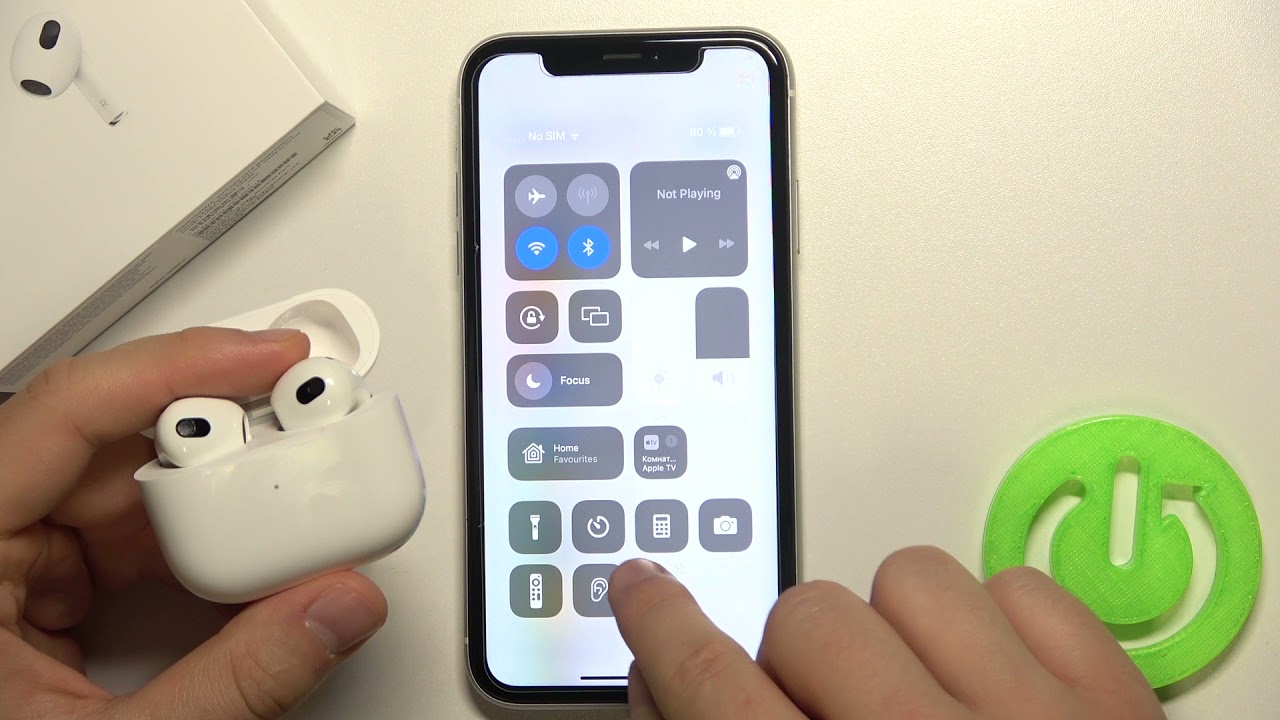Introduction:
Noise cancellation technology has revolutionized the listening experience for audio enthusiasts around the world. With the advent of advanced wireless earbuds like AirPods, noise cancellation is no longer limited to bulky headphones. These sleek and compact earbuds now offer an immersive audio experience by effectively blocking out external noises.
Noise cancellation technology works by using built-in microphones to analyze surrounding sounds and generate opposing sound waves that cancel out unwanted noise. This innovative feature has become a game-changer for those who want to enjoy their favorite music, podcasts, or audio content without any distractions.
Whether you are a frequent traveler looking for peace during long flights or someone trying to focus in a noisy workplace, noise cancellation on AirPods can be a game-changer. In this article, we will explore how noise cancellation works, the benefits it provides, different types of noise cancellation on AirPods, and how to enable this feature on your device.
Let us embark on a journey to uncover the wonders of noise cancellation and discover how AirPods can deliver a remarkable audio experience in any environment.
How Does Noise Cancellation Work?
Noise cancellation technology is based on the principle of physics and sound wave interference. It involves the use of microphones and advanced algorithms to mitigate external noise and provide a serene listening experience.
When you wear noise-canceling AirPods, the built-in microphones detect incoming sounds from your surroundings. These microphones capture the ambient noise and send the audio signal to the onboard processor. The processor then analyzes the noise and generates an equal but opposite sound wave, commonly referred to as the “anti-noise.”
The anti-noise sound wave is then played through the speakers of the AirPods. As this anti-noise wave interacts with the external noise in your surroundings, they cancel each other out through a phenomenon called destructive interference. This cancellation happens so fast that you perceive a significant reduction in the background noise.
The noise cancellation technology in AirPods continuously adjusts and adapts to the changing environment. The microphones, along with the advanced algorithms, monitor the surrounding sounds and adjust the amplitude and frequency of the anti-noise wave in real-time to ensure optimum noise cancellation.
By canceling out unwanted noise, noise cancellation technology allows you to focus on your audio content without distractions. Whether you’re in a bustling coffee shop, on a crowded train, or in a noisy office, noise cancellation helps create a personal oasis of tranquility for your listening pleasure.
It’s important to note that noise cancellation is most effective at blocking out continuous sounds, such as the hum of an airplane or the rumble of a train. It may not be as effective in eliminating sudden, sharp sounds, such as door slams or honking horns. However, the technology is constantly evolving, and newer versions of AirPods are becoming better at addressing these challenges.
Benefits of Noise Cancellation on AirPods
Noise cancellation on AirPods offers a range of benefits that enhance the overall listening experience. Here are some of the key advantages of using noise cancellation technology:
- Immersive Audio: Noise cancellation technology allows you to immerse yourself fully in your audio content. By blocking out external distractions, you can focus on the intricate details of your music, podcasts, or movies, and enjoy them with greater clarity.
- Reduced Stress and Fatigue: Loud and constant noise can lead to increased stress and fatigue. With noise cancellation on AirPods, you can create a peaceful listening environment, even in the midst of a chaotic setting. This can help alleviate stress and make long commutes or work hours more bearable.
- Improved Concentration: Noise-canceling AirPods help improve concentration by eliminating background noise. Whether you’re studying, working, or reading, the absence of distractions allows you to focus better and be more productive.
- Enhanced Travel Experience: For frequent travelers, noise cancellation is a game-changer. It can make long flights more pleasant by minimizing the sound of engine noise or crying babies. You can enjoy your favorite music or movies without being disturbed by the ambient noise in the airplane cabin.
- Better Call Quality: Noise cancellation technology not only cancels out external noise but also enhances the clarity of your voice during phone calls. The microphones in AirPods capture your voice more accurately by reducing background noise, ensuring that your conversations are clear and intelligible.
- Preservation of Hearing: With noise cancellation, you can listen to audio content at lower volumes. By reducing the need to raise the volume to overcome ambient noise, you can protect your hearing and reduce the risk of long-term damage.
These benefits make noise cancellation on AirPods a valuable feature for anyone seeking a more immersive and enjoyable listening experience. Whether you’re a music lover, frequent traveler, or someone looking for a quieter work environment, noise cancellation technology can elevate your audio experience to new heights.
Types of Noise Cancellation on AirPods
AirPods offer different types of noise cancellation technologies that cater to varying preferences and needs. Here are the two main types of noise cancellation available on AirPods:
- Active Noise Cancellation (ANC): This is the standard noise cancellation technology found in AirPods Pro. ANC uses advanced microphones to continuously monitor and analyze environmental noise. It generates anti-noise waves that cancel out external sounds before they reach your ears. ANC is highly effective at reducing low-frequency noises like engine rumble or background chatter, providing a more immersive audio experience.
- Adaptive Noise Cancellation: AirPods Max feature a custom-designed dynamic driver that adapts to the fit and seal of the ear cups. This adaptive noise cancellation technology adjusts the sound signal to optimize the noise cancellation based on the user’s specific fit. It ensures a consistent and tailored noise cancellation experience regardless of different ear shapes and sizes.
Both ANC and adaptive noise cancellation technologies offer significant benefits, but each is designed for different AirPods models to suit various user preferences and use cases. ANC is ideal for those seeking a lightweight and portable option, while adaptive noise cancellation on AirPods Max provides a premium and customized audio experience.
Whichever type of noise cancellation you choose, you can expect a significant reduction in background noise and an enhanced audio experience with AirPods.
Transparency Mode: An Alternate to Noise Cancellation
In addition to noise cancellation, AirPods offer a unique feature called Transparency Mode. While noise cancellation aims to block out surrounding noise, Transparency Mode takes a different approach by allowing you to perceive and hear the sounds of your environment while still enjoying your audio content.
With Transparency Mode enabled, AirPods use external microphones to capture the sounds around you and play them back in your ears. This feature is particularly useful when you need to be aware of your surroundings, such as during outdoor workouts or when crossing busy streets.
Transparency Mode is designed to offer a more natural and immersive listening experience. By letting in ambient noise, it allows you to have conversations, hear announcements, or simply be more aware of your surroundings without needing to pause or remove your AirPods.
Enabling Transparency Mode is straightforward. You can either activate it through your AirPods settings on your connected device or use the control center on your iOS device to toggle the feature on and off with a single tap.
Whether you prefer the complete isolation of noise cancellation or the awareness provided by Transparency Mode, AirPods give you the flexibility to choose the mode that best suits your needs and preferences. Switching between the two modes is effortless, allowing you to adapt to different situations and environments on-the-go.
Overall, Transparency Mode serves as a versatile feature on AirPods that provides both convenience and safety, making it a valuable alternative to noise cancellation.
How to Enable Noise Cancellation on AirPods
Enabling noise cancellation on your AirPods is a simple and straightforward process. Here’s a step-by-step guide on how to activate this feature:
- Ensure that your AirPods are connected to the device you want to use.
- Open the control center on your iOS device. On iPhone or iPad, swipe down from the top-right corner of the screen. On newer iPhones without the Home button, swipe up from the bottom of the screen.
- Find the Now Playing card, which displays the audio currently playing on your device. This may include media like music, podcasts, or videos.
- Tap on the AirPlay icon in the top-right corner of the Now Playing card. It looks like an upward-pointing triangle enclosed in a circle.
- In the list of available audio devices, locate your AirPods and tap on them.
- A submenu will appear, showing different audio options for your AirPods. Tap on “Noise Cancellation” to enable this feature.
- Once noise cancellation is enabled, your AirPods will actively block out external noise, providing a more immersive audio experience.
It’s important to note that noise cancellation is available on certain AirPods models, such as AirPods Pro or AirPods Max. If you have a different version of AirPods, you may not have access to this feature.
With noise cancellation enabled, you can enjoy your favorite audio content with reduced background noise and distractions, immersing yourself in a world of pristine sound quality.
Limitations of Noise Cancellation on AirPods
While noise cancellation on AirPods offers numerous benefits, it is important to understand its limitations. Here are some of the common limitations you may encounter:
- Ineffectiveness with Sudden Sounds: Noise cancellation is most effective at reducing continuous background noise, such as the hum of an airplane engine or the rumble of a train. However, it may not be as effective in canceling sudden, sharp sounds like door slams or honking horns. These sounds can still penetrate through the noise cancellation technology.
- Loss of Spatial Awareness: Noise cancellation creates a sealed audio environment, which may result in a loss of spatial awareness. You may find it challenging to judge the distance or direction of sounds in your surroundings. It is essential to exercise caution when using noise cancellation in situations where maintaining awareness of your surroundings is crucial, such as walking in busy streets.
- Battery Consumption: Noise cancellation technology requires additional processing power and active microphones, which can lead to increased battery consumption. While AirPods are designed to provide a reasonable battery life, using noise cancellation for extended periods may drain the battery faster than usual. It is advisable to monitor your battery levels and recharge as needed.
- Fit and Seal: Noise cancellation effectiveness can be influenced by the fit and seal of the AirPods in your ears. If your AirPods do not fit properly or have a poor seal, external noise may still leak in, reducing the overall effectiveness of noise cancellation. It is important to ensure a secure fit and experiment with different ear tips or ear cushions to optimize the noise cancellation experience.
- Compatibility: Noise cancellation features may not be available on all AirPods models. Models such as AirPods Pro and AirPods Max offer noise cancellation, while older versions may not have this capability. It is essential to check the specifications of your AirPods to determine if they support noise cancellation.
Despite these limitations, noise cancellation technology on AirPods remains highly effective and provides a substantial reduction in ambient noise. It is important to understand its capabilities and use it wisely according to the intended purpose and environment.
Conclusion
Noise cancellation technology on AirPods has transformed the way we listen to audio. By blocking out external noises and distractions, noise cancellation allows us to immerse ourselves in our favorite music, podcasts, and movies, creating a more enjoyable and focused listening experience. Whether you’re a frequent traveler, a student trying to concentrate, or someone seeking a moment of peace in a noisy environment, noise cancellation on AirPods can be a game-changer.
Understanding how noise cancellation works and the benefits it provides helps us appreciate the advancements in audio technology. With active noise cancellation (ANC) and adaptive noise cancellation available on different AirPods models, users have the flexibility to choose the right level of noise cancellation that suits their preferences and needs.
Additionally, AirPods offer an alternative to noise cancellation with Transparency Mode, which allows you to hear and be aware of your surroundings while still enjoying your audio content. This feature provides a versatile listening experience for various situations and environments.
Enabling noise cancellation on AirPods is a simple process, and it opens up a world of immersive and high-quality audio. However, it is important to be aware of the limitations of noise cancellation, such as its effectiveness with sudden sounds and the need for a proper fit and seal for optimal performance.
In conclusion, noise cancellation technology on AirPods enhances our listening experiences by minimizing distractions and allowing us to focus on what matters most – the audio content. Whether it’s for work, travel, or leisure, noise cancellation helps create a serene and personalized audio environment, delivering a truly remarkable listening experience.

























